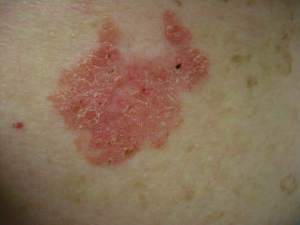What is Bowen’s Disease?
Bowen’s disease occurs when early abnormal skin cells grow within the top layer of the skin. Furthermore, these patches may occur singly or in multiples. The condition is non-invasive but can progress if left untreated.
What Causes Bowen’s Disease to Develop?
The most common cause of Bowen’s disease is long-term exposure to ultraviolet (UV) light, either from sunlight or sunbeds. It is especially common in fair-skinned people who have lived abroad, worked outdoors or frequently sunbathed.
Ultraviolet light damages the outer layer of the skin. This causes cells to overgrow and produce small red scaly lesions. UV exposure also contributes to premature ageing, wrinkles, flat brown pigmented skin lesions (“sun spots”), and increases the risk of skin cancers.
Other contributing factors include:
- Arsenic exposure (historically from tonics such as “Parisher’s Food” given to children between the 1930s – 1950s).
Are Patches of Bowen’s Disease Harmful?
In most cases, Bowen’s disease is slow-growing and not immediately harmful if no symptoms are present. However, around 1 in 200 lesions per year may progress into invasive squamous cell carcinoma.
Signs that a lesion may be changing include:
- Thickening of the patch.
- Development of a lump or ulcer within the area.
Bowen’s disease is also a marker of overall sun damage, which means patients may be at higher risk of developing other skin cancers.
Is Treatment for Bowen’s Disease Always Necessary?
While some patches can remain unchanged for years, most do not disappear on their own. Although, treatment is advised when:
- Lesions are causing discomfort or irritation
- They are spreading or cosmetically distressing
- There is concern about cancer progression
We offer personalised private Bowen’s disease treatment in Sussex, including options for treating single or multiple lesions.
Treatment Options for Bowen’s Disease
Patients are encouraged to use a daily moisturiser with SPF 15 or higher, especially on sun-exposed skin. For persistent or high-risk lesions, the following treatments may be recommended:
Efudix® Cream (5-Fluorouracil)
- Applied twice daily for 3 weeks or once daily for 6 weeks
- Destroys abnormal skin cells and triggers inflammation
- Redness, crusting, and occasional ulceration are expected
- Highly effective (85%), especially for multiple unstable patches
- May require topical steroid/antibiotic if the reaction is intense
Cryotherapy (Liquid Nitrogen Freezing)
- Quick freezing of the lesion to destroy abnormal cells
- Healing takes 7–15 days (longer on legs)
- Relatively painful but effective in 90% of cases with a single session
- May cause temporary blistering, crusting or permanent white scarring
Photodynamic Therapy (Metvix PDT®)
- Cream selectively targets abnormal cells
- Activated by red light to destroy precancerous tissue
- Best for extensive patches (face or body)
- Multiple treatments may be required
- 70–75% effective per session
- Short healing time (7–10 days) with good cosmetic outcomes
Curettage and Cautery
- Scraping and cauterising the lesion under local anaesthetic
- Recommended for crusty, thickened, or suspicious looking lesions
- Tissue is often sent for biopsy
- Healing takes 10–21 days, possibly longer on the lower leg
- Leaves a small white or pink scar
All treatments are delivered by experienced Consultant Dermatologists as part of our Bowen’s disease treatment in Sussex.
Should I Have Regular Skin Checks?
Routine follow-up isn’t always necessary for Bowen’s disease. However, if you have multiple lesions, or a personal history of skin cancer, we recommend a skin review with one of our consultant dermatologists once or twice a year.
Please note: routine skin checks are not typically available through NHS dermatology clinics, but we provide this privately.
What Can I Do to Help Prevent Further Patches?
Prevention is an important part of managing Bowen’s disease.
Protective strategies include:
- Wearing lightweight, long-sleeved clothing and a wide-brimmed hat
- Applying SPF 25+ sunscreen daily
- Avoiding sunbeds and peak sunlight hours (11am–3pm)
- Checking your skin regularly for new or changing lesions
Reducing UV exposure can help slow the development of future patches and improve skin health over time.
Book Your Bowen’s Disease Treatment in Sussex

If you’re experiencing new patches of red, scaly skin or have been diagnosed with Bowen’s disease, don’t delay seeking care. Early treatment reduces the risk of progression and improves cosmetic outcomes.
Our Consultant Dermatologists offer expert, evidence-based Bowen’s disease treatment in Sussex, with rapid access and compassionate support.
Contact us today to arrange your consultation and receive trusted Bowen’s disease patient information, diagnosis and care.
